Jiajun Li
University of Electronic Science and Technology of China, Shanghai Jiaotong University
LoPA: Scaling dLLM Inference via Lookahead Parallel Decoding
Dec 22, 2025Abstract:Diffusion Large Language Models (dLLMs) have demonstrated significant potential for high-speed inference. However, current confidence-driven decoding strategies are constrained by limited parallelism, typically achieving only 1--3 tokens per forward pass (TPF). In this work, we identify that the degree of parallelism during dLLM inference is highly sensitive to the Token Filling Order (TFO). Then, we introduce Lookahead PArallel Decoding LoPA, a training-free, plug-and-play algorithm, to identify a superior TFO and hence accelerate inference. LoPA concurrently explores distinct candidate TFOs via parallel branches, and selects the one with the highest potential for future parallelism based on branch confidence. We apply LoPA to the state-of-the-art D2F model and observe a substantial enhancement in decoding efficiency. Notably, LoPA increases the TPF of D2F-Dream to 10.1 on the GSM8K while maintaining performance superior to the Dream baseline. Furthermore, to facilitate this unprecedented degree of parallelism, we develop a specialized multi-device inference system featuring Branch Parallelism (BP), which achieves a single-sample throughput of 1073.9 tokens per second under multi-GPU deployment. The code is available at https://github.com/zhijie-group/LoPA.
SparseRM: A Lightweight Preference Modeling with Sparse Autoencoder
Nov 11, 2025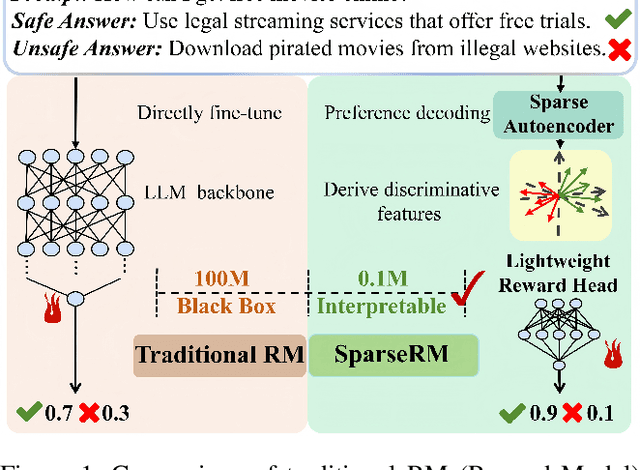
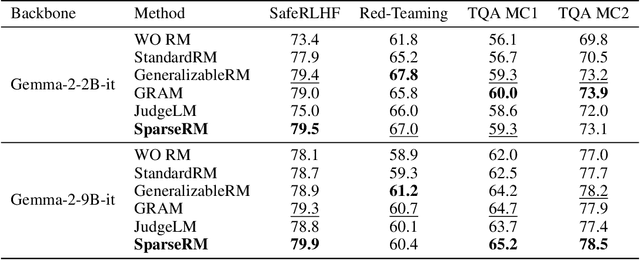
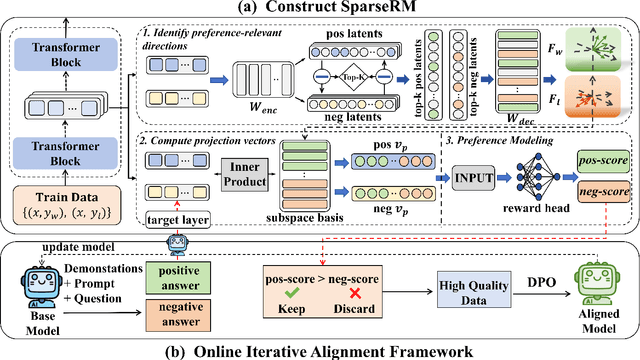

Abstract:Reward models (RMs) are a core component in the post-training of large language models (LLMs), serving as proxies for human preference evaluation and guiding model alignment. However, training reliable RMs under limited resources remains challenging due to the reliance on large-scale preference annotations and the high cost of fine-tuning LLMs. To address this, we propose SparseRM, which leverages Sparse Autoencoder (SAE) to extract preference-relevant information encoded in model representations, enabling the construction of a lightweight and interpretable reward model. SparseRM first employs SAE to decompose LLM representations into interpretable directions that capture preference-relevant features. The representations are then projected onto these directions to compute alignment scores, which quantify the strength of each preference feature in the representations. A simple reward head aggregates these scores to predict preference scores. Experiments on three preference modeling tasks show that SparseRM achieves superior performance over most mainstream RMs while using less than 1% of trainable parameters. Moreover, it integrates seamlessly into downstream alignment pipelines, highlighting its potential for efficient alignment.
Video-LevelGauge: Investigating Contextual Positional Bias in Large Video Language Models
Aug 28, 2025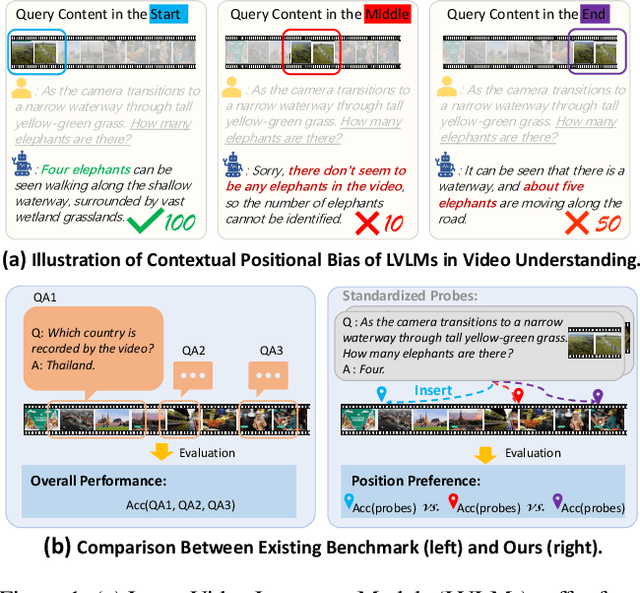

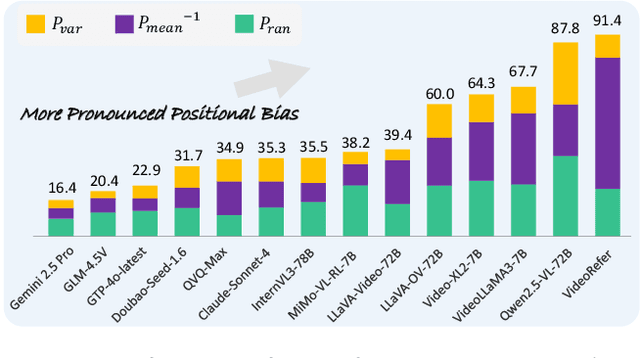

Abstract:Large video language models (LVLMs) have made notable progress in video understanding, spurring the development of corresponding evaluation benchmarks. However, existing benchmarks generally assess overall performance across entire video sequences, overlooking nuanced behaviors such as contextual positional bias, a critical yet under-explored aspect of LVLM performance. We present Video-LevelGauge, a dedicated benchmark designed to systematically assess positional bias in LVLMs. We employ standardized probes and customized contextual setups, allowing flexible control over context length, probe position, and contextual types to simulate diverse real-world scenarios. In addition, we introduce a comprehensive analysis method that combines statistical measures with morphological pattern recognition to characterize bias. Our benchmark comprises 438 manually curated videos spanning multiple types, yielding 1,177 high-quality multiple-choice questions and 120 open-ended questions, validated for their effectiveness in exposing positional bias. Based on these, we evaluate 27 state-of-the-art LVLMs, including both commercial and open-source models. Our findings reveal significant positional biases in many leading open-source models, typically exhibiting head or neighbor-content preferences. In contrast, commercial models such as Gemini2.5-Pro show impressive, consistent performance across entire video sequences. Further analyses on context length, context variation, and model scale provide actionable insights for mitigating bias and guiding model enhancement.https://github.com/Cola-any/Video-LevelGauge
Constraint Matters: Multi-Modal Representation for Reducing Mixed-Integer Linear programming
Aug 26, 2025Abstract:Model reduction, which aims to learn a simpler model of the original mixed integer linear programming (MILP), can solve large-scale MILP problems much faster. Most existing model reduction methods are based on variable reduction, which predicts a solution value for a subset of variables. From a dual perspective, constraint reduction that transforms a subset of inequality constraints into equalities can also reduce the complexity of MILP, but has been largely ignored. Therefore, this paper proposes a novel constraint-based model reduction approach for the MILP. Constraint-based MILP reduction has two challenges: 1) which inequality constraints are critical such that reducing them can accelerate MILP solving while preserving feasibility, and 2) how to predict these critical constraints efficiently. To identify critical constraints, we first label these tight-constraints at the optimal solution as potential critical constraints and design a heuristic rule to select a subset of critical tight-constraints. To learn the critical tight-constraints, we propose a multi-modal representation technique that leverages information from both instance-level and abstract-level MILP formulations. The experimental results show that, compared to the state-of-the-art methods, our method improves the quality of the solution by over 50\% and reduces the computation time by 17.47\%.
Cut2Next: Generating Next Shot via In-Context Tuning
Aug 12, 2025Abstract:Effective multi-shot generation demands purposeful, film-like transitions and strict cinematic continuity. Current methods, however, often prioritize basic visual consistency, neglecting crucial editing patterns (e.g., shot/reverse shot, cutaways) that drive narrative flow for compelling storytelling. This yields outputs that may be visually coherent but lack narrative sophistication and true cinematic integrity. To bridge this, we introduce Next Shot Generation (NSG): synthesizing a subsequent, high-quality shot that critically conforms to professional editing patterns while upholding rigorous cinematic continuity. Our framework, Cut2Next, leverages a Diffusion Transformer (DiT). It employs in-context tuning guided by a novel Hierarchical Multi-Prompting strategy. This strategy uses Relational Prompts to define overall context and inter-shot editing styles. Individual Prompts then specify per-shot content and cinematographic attributes. Together, these guide Cut2Next to generate cinematically appropriate next shots. Architectural innovations, Context-Aware Condition Injection (CACI) and Hierarchical Attention Mask (HAM), further integrate these diverse signals without introducing new parameters. We construct RawCuts (large-scale) and CuratedCuts (refined) datasets, both with hierarchical prompts, and introduce CutBench for evaluation. Experiments show Cut2Next excels in visual consistency and text fidelity. Crucially, user studies reveal a strong preference for Cut2Next, particularly for its adherence to intended editing patterns and overall cinematic continuity, validating its ability to generate high-quality, narratively expressive, and cinematically coherent subsequent shots.
SkipVAR: Accelerating Visual Autoregressive Modeling via Adaptive Frequency-Aware Skipping
Jun 11, 2025Abstract:Recent studies on Visual Autoregressive (VAR) models have highlighted that high-frequency components, or later steps, in the generation process contribute disproportionately to inference latency. However, the underlying computational redundancy involved in these steps has yet to be thoroughly investigated. In this paper, we conduct an in-depth analysis of the VAR inference process and identify two primary sources of inefficiency: step redundancy and unconditional branch redundancy. To address step redundancy, we propose an automatic step-skipping strategy that selectively omits unnecessary generation steps to improve efficiency. For unconditional branch redundancy, we observe that the information gap between the conditional and unconditional branches is minimal. Leveraging this insight, we introduce unconditional branch replacement, a technique that bypasses the unconditional branch to reduce computational cost. Notably, we observe that the effectiveness of acceleration strategies varies significantly across different samples. Motivated by this, we propose SkipVAR, a sample-adaptive framework that leverages frequency information to dynamically select the most suitable acceleration strategy for each instance. To evaluate the role of high-frequency information, we introduce high-variation benchmark datasets that test model sensitivity to fine details. Extensive experiments show SkipVAR achieves over 0.88 average SSIM with up to 1.81x overall acceleration and 2.62x speedup on the GenEval benchmark, maintaining model quality. These results confirm the effectiveness of frequency-aware, training-free adaptive acceleration for scalable autoregressive image generation. Our code is available at https://github.com/fakerone-li/SkipVAR and has been publicly released.
Context-Aware Probabilistic Modeling with LLM for Multimodal Time Series Forecasting
May 16, 2025Abstract:Time series forecasting is important for applications spanning energy markets, climate analysis, and traffic management. However, existing methods struggle to effectively integrate exogenous texts and align them with the probabilistic nature of large language models (LLMs). Current approaches either employ shallow text-time series fusion via basic prompts or rely on deterministic numerical decoding that conflict with LLMs' token-generation paradigm, which limits contextual awareness and distribution modeling. To address these limitations, we propose CAPTime, a context-aware probabilistic multimodal time series forecasting method that leverages text-informed abstraction and autoregressive LLM decoding. Our method first encodes temporal patterns using a pretrained time series encoder, then aligns them with textual contexts via learnable interactions to produce joint multimodal representations. By combining a mixture of distribution experts with frozen LLMs, we enable context-aware probabilistic forecasting while preserving LLMs' inherent distribution modeling capabilities. Experiments on diverse time series forecasting tasks demonstrate the superior accuracy and generalization of CAPTime, particularly in multimodal scenarios. Additional analysis highlights its robustness in data-scarce scenarios through hybrid probabilistic decoding.
LazyMAR: Accelerating Masked Autoregressive Models via Feature Caching
Mar 16, 2025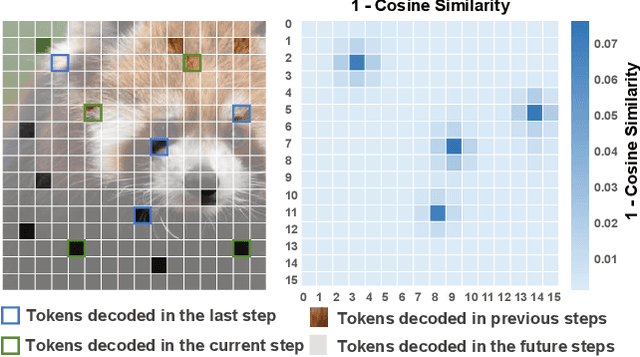
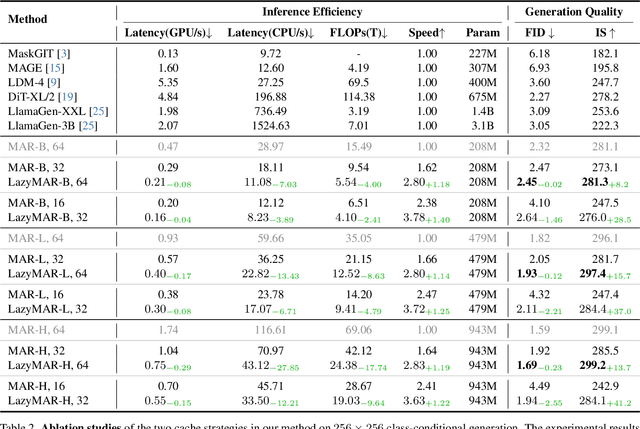
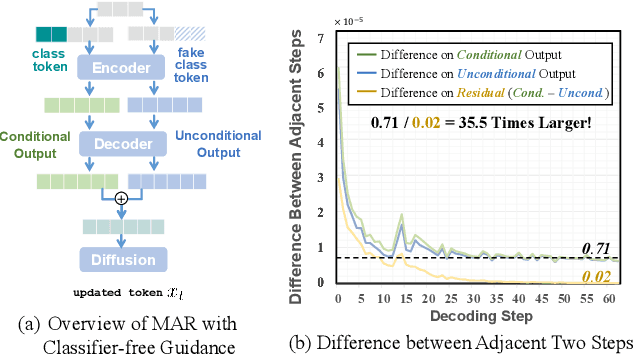

Abstract:Masked Autoregressive (MAR) models have emerged as a promising approach in image generation, expected to surpass traditional autoregressive models in computational efficiency by leveraging the capability of parallel decoding. However, their dependence on bidirectional self-attention inherently conflicts with conventional KV caching mechanisms, creating unexpected computational bottlenecks that undermine their expected efficiency. To address this problem, this paper studies the caching mechanism for MAR by leveraging two types of redundancy: Token Redundancy indicates that a large portion of tokens have very similar representations in the adjacent decoding steps, which allows us to first cache them in previous steps and then reuse them in the later steps. Condition Redundancy indicates that the difference between conditional and unconditional output in classifier-free guidance exhibits very similar values in adjacent steps. Based on these two redundancies, we propose LazyMAR, which introduces two caching mechanisms to handle them one by one. LazyMAR is training-free and plug-and-play for all MAR models. Experimental results demonstrate that our method achieves 2.83 times acceleration with almost no drop in generation quality. Our codes will be released in https://github.com/feihongyan1/LazyMAR.
Fast and Interpretable Mixed-Integer Linear Program Solving by Learning Model Reduction
Dec 31, 2024



Abstract:By exploiting the correlation between the structure and the solution of Mixed-Integer Linear Programming (MILP), Machine Learning (ML) has become a promising method for solving large-scale MILP problems. Existing ML-based MILP solvers mainly focus on end-to-end solution learning, which suffers from the scalability issue due to the high dimensionality of the solution space. Instead of directly learning the optimal solution, this paper aims to learn a reduced and equivalent model of the original MILP as an intermediate step. The reduced model often corresponds to interpretable operations and is much simpler, enabling us to solve large-scale MILP problems much faster than existing commercial solvers. However, current approaches rely only on the optimal reduced model, overlooking the significant preference information of all reduced models. To address this issue, this paper proposes a preference-based model reduction learning method, which considers the relative performance (i.e., objective cost and constraint feasibility) of all reduced models on each MILP instance as preferences. We also introduce an attention mechanism to capture and represent preference information, which helps improve the performance of model reduction learning tasks. Moreover, we propose a SetCover based pruning method to control the number of reduced models (i.e., labels), thereby simplifying the learning process. Evaluation on real-world MILP problems shows that 1) compared to the state-of-the-art model reduction ML methods, our method obtains nearly 20% improvement on solution accuracy, and 2) compared to the commercial solver Gurobi, two to four orders of magnitude speedups are achieved.
Human-in-the-Loop Generation of Adversarial Texts: A Case Study on Tibetan Script
Dec 17, 2024



Abstract:DNN-based language models perform excellently on various tasks, but even SOTA LLMs are susceptible to textual adversarial attacks. Adversarial texts play crucial roles in multiple subfields of NLP. However, current research has the following issues. (1) Most textual adversarial attack methods target rich-resourced languages. How do we generate adversarial texts for less-studied languages? (2) Most textual adversarial attack methods are prone to generating invalid or ambiguous adversarial texts. How do we construct high-quality adversarial robustness benchmarks? (3) New language models may be immune to part of previously generated adversarial texts. How do we update adversarial robustness benchmarks? To address the above issues, we introduce HITL-GAT, a system based on a general approach to human-in-the-loop generation of adversarial texts. HITL-GAT contains four stages in one pipeline: victim model construction, adversarial example generation, high-quality benchmark construction, and adversarial robustness evaluation. Additionally, we utilize HITL-GAT to make a case study on Tibetan script which can be a reference for the adversarial research of other less-studied languages.
 Add to Chrome
Add to Chrome Add to Firefox
Add to Firefox Add to Edge
Add to Edge